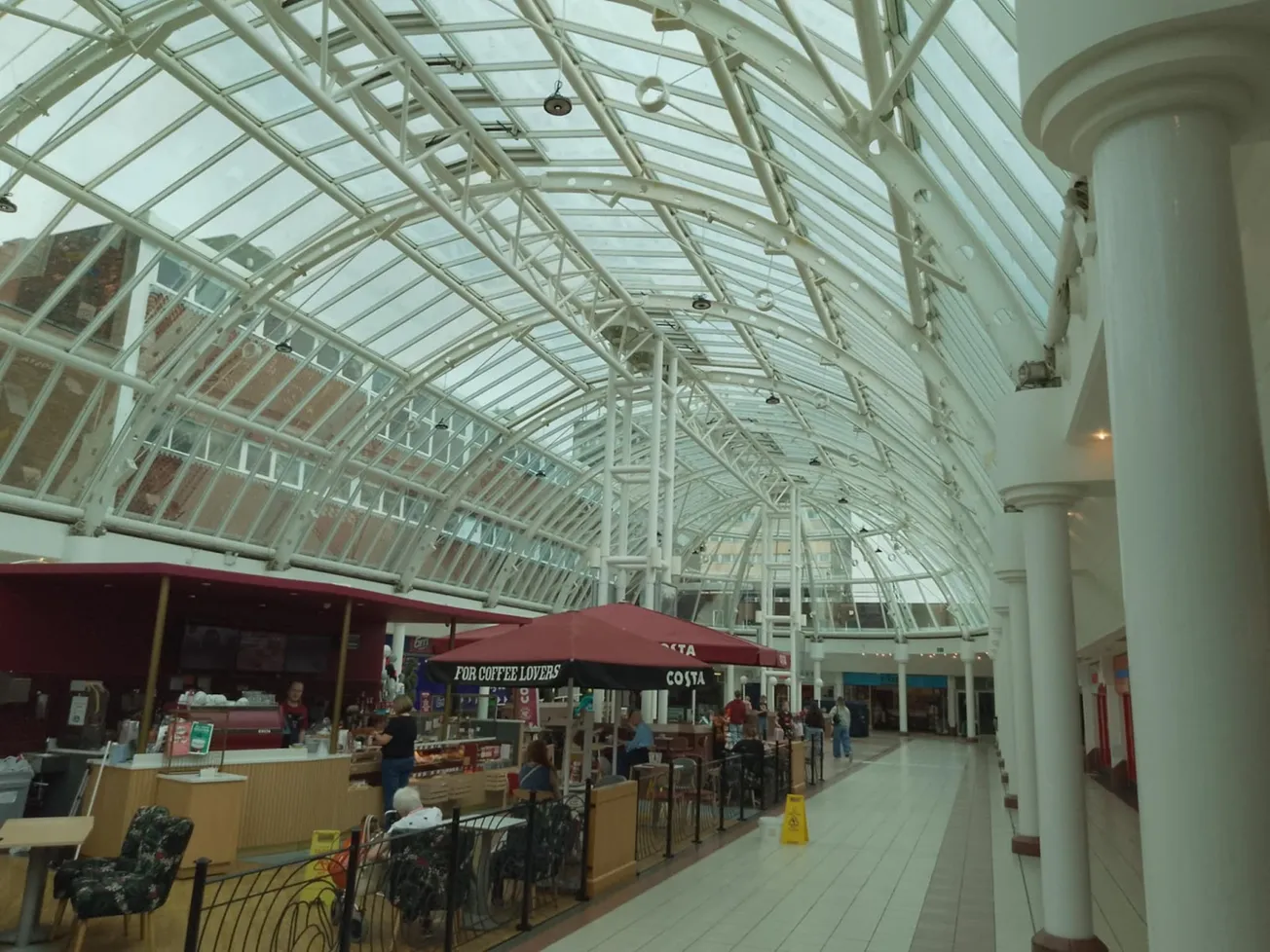Against the odds, Liscard is winning

With neither Birkenhead’s “renaissance” or New Brighton’s “revival”, one Wirral town is keeping calm and carrying on
Let’s play a game. I’m thinking of a Merseyside town. I want you to guess what it is.
Some clues: this town first experienced its boom years amid the steel and smog of the Victorian era. By the mid-20th century, it was a bustling retail destination, home to Woolworths, Boots, and Marks & Spencers branches. Then came the blow of deindustrialisation, leaving less money in people’s pockets across the North West. The town started to falter; the 2008 financial crash and ensuing 14 years of austerity was crippling.
Impossible to narrow it down, right? The story I’m recounting could be that of central Birkenhead, with its rows of empty shop fronts and hollowed-out market hall, or Wavertree, where each open store is interspersed with two or three shuttered facades. It applies to any number of other places across Merseyside and the country fighting to defibrillate their high streets. But on this occasion, I’m talking about Liscard, a town that defined my formative years.
I’m not from here, exactly; I grew up closer to New Brighton, by then a sun-faded polaroid of a seaside resort. But I went to school at St Albans, the primary opposite the giro, the Cherry Tree shopping centre and the tower block of Liscard House, which might as well have been the Empire State Building when I was that age. And Liscard was “the shops” – the shops, where my friends and I would walk to spend pocket money on pick ‘n’ mix from Woolworths, or buy records or comics at a number of eclectic outlets down Mill Lane and Liscard Road.
But that was before online shopping and government cuts. Now, it’s surely different. Back in January 2023, Liscard’s neighbours were getting millions in Levelling Up funding. Knowsley Council was awarded £15 million to spend on Halewood’s leisure facilities and their St Helens counterparts received £20 million for Earlestown’s regeneration. But Wirral’s bid for £30 million to resurrect Liscard’s town centre — branded a “hotspot” for anti-social behaviour by Merseyside Police — was knocked back. Coincidentally, Wirral Council itself had a £30 million deficit at the time. Council leader and Liscard ward rep, Janette Williamson, had told The Post the previous October: “We can’t trim the fat, there isn’t any fat. There isn’t even any bone”.
Socioeconomic decline is exhausting, banal, and ubiquitous. The superficial signs are grindingly familiar. Whitewashed shop fronts, smashed windows and To Let signs. But few people notice the grey contempt that spreads like water damage into everything: not just scratched out signage or gum-marked pavements, but attitudes. I recently suggested a night out here instead of the rejuvenated near-by New Brighton, to which a friend replied that Liscard was “a shithole”. When I tell a shopkeeper on Liscard Road I’m writing about the place, I’m met with an attitude of utter bewilderment: “Now why in God’s name would you do that?”
But there’s been a glint of sunlight. Not long after the £30 million knockback, a second, more modest bid for Levelling Up funds was successful. £12 million was approved to regenerate the area, with most funds allocated for Mother Redcap Place, the area around the McDonald’s named for a semi-legendary local smuggler. But necessary demolitions have already begun: the tearing down of the former municipal building off Seaview Road after an extensive asbestos removal. A hundred new homes are to be built on that site, where regular vandalism had been a persistent thorn in the council’s side. In the early stages of a long-awaited make-over, Liscard makes for an interesting case study.
Liscard had to fight even for this £12 million, of course. The incoming Labour government found many Levelling Up purses to be teetering dangerously close to the event horizon of their £22 billion “black hole.” But even before a spade has met the ground, I do not find Liscard dull, dreary, or in any way disheartening. In fact, on a sunny Saturday afternoon, it’s half a dozen shoppers short of “bustling”.
If you want more stories like this delivered directly to you via email, you can sign up to The Post's free mailing list using the button below.
Let’s dispense with the downsides. Woolworths is long gone, of course, as are other big retailers like Curry’s, Burtons, Wilko’s, and the old Manweb store. The cladding on Liscard House isn’t going to win architectural prizes any time soon. The Art Deco ABC cinema is just a relic. Of the two grand 19th century structures that bear the town’s name — Liscard Battery and Liscard Hall — one’s actually in New Brighton and the other’s been torn down. Darren, a smoker I speak to outside the Wetherspoons, points his pint at the dilapidated Dominick House — the former Job Centre — and jokes that even the giro’s on the sick.
But inside the Cherry Tree Centre, you’ll find most of the shop units open. I was expecting a ghost town, like when I recently visited Birkenhead Market. Instead, there’s a decent array of charity shops, cafes, a supermarket, a haberdashery and Beresford’s, a local butcher’s. In the main atrium beneath the glass roof, there’s even a few foldaway stalls selling jewellery and other accessories. Sitting and watching the women sell their wares, I get talking to Carol, who’s lived in the area since the 1960s — “back when it was posh.”
“This was all open air, once,” she says, gesturing at the glass roof above. “And down here,” she points across the stalls to the Costa Coffee tables, “there were all cherry trees – real cherry trees. If the wind blew through, you’d be swept away in the white blossom.” But even without that brilliant foliage, Carol continues to visit, sometimes taking her grandson for a cake in Waterfields.
Returning on a Tuesday, Liscard seems no more abandoned than it did on the weekend. In fact, the short walk from one side of town to the other reveals that Liscard has retained the eclecticism I’d remembered. Dark Earth Records on Seaview Road sells LPs, books, and zines. It’s also a general hang out for goths or horror aficionados, hosting events with artists or authors, such as Ramsey Campbell. Then there’s collector’s treasure trove Psychamok, also selling records, books, and DVDs.
Pawing through a cardboard box of American comics reminds me of coming to Psychamok as a teenager with my late uncle, seldom leaving without a small portfolio of X-Mens. Under the watchful gaze of a two-and-a-half foot Darth Vader figure, I ask Andy Brown — Psychamok’s proprietor for 20 years — how Liscard has managed to stay busy despite underinvestment.
“Well, if you look at Birkenhead and [the Pyramids shopping centre] not only is so much of it closed down, it’s now inaccessible with all the roadworks,” Andy says. “That may have driven people here instead.”
Andy wonders whether Liscard’s bustle will survive Birkenhead’s delayed regeneration. And like a few people I speak to, he’s guarded about whether they’ll ever see the promised £12 million: a cynicism born from experience. But as the day fades, further examples of Liscard’s tenacity become apparent. First, its diverse selection of restaurants: American-style Chuck Wagon, highly-rated pizzeria Captain Tony’s, and the Nepalese eatery Mount Everest.
Secondly, its nightlife: the entertaining dive bar Soft Rock may have gone, replaced by the surprisingly high-end “fine drinking” establishment Après Ski, but there’s still the cask ale joint the Scrap Yard around the corner, popular family pub The Boot, and no fewer than two cosy micropubs in the Twelve-Sixty and the Lazy Landlord. (Wetherspoons, of course, requires no advertisement from me, but I will confess that I found £2.19 for a pint of Jaipur – something I last paid £7.20 for in the Sheffield Tap — an irresistible proposition on my journey between the Yard and the Twelve-Sixty.)
I speak to Liscard councillor Graeme Cooper about the area’s past, present and future; its retail section and active nightlife. “The Cherry Tree Centre has been a really positive success story for Liscard,” he says. Like Carol, he also remembers the open top and blossom trees of decades past, but, more recently, last year’s summer fayre, improved upon this season with a farmer’s market. “We also had a very successful Christmas fayre over three days, with outdoor musicians under a gazebo and Chinese dragon dancers, and children from the local youth group doing sound and light projections onto the buildings.”
Cooper acknowledges the challenges the town’s faced, such as anti-social behaviour and the lack of a real community hub — issues the council are looking to address. But he’s keen to point out that few of these are unique to Liscard. And for a place primarily known as a retail centre, its 10,000 population has a good community spirit. Liscard House tower block — which, Cooper says, is getting its cladding replaced soon — is even a desirable place to live, especially the upper floors. “You can see right across to Anglesey, Moel Famau and the Clwydian Range, and even Blackpool Tower on a clear day.”
Councillor Janette Williamson is also unequivocal about Liscard’s setbacks, especially major retailers and a number of high street banks closing their branches. Nevertheless, “Liscard is an amazing place to live and shop,” she says, and has “seen an increase in local independent businesses, and community-led initiatives and music events.” With the £12 million funding boost, she is confident that “Liscard is leading the way in terms of town centre revival.”
Compared with some of the Levelling Up war chests, themselves pittances when measured against the funding that’s really required – £12 million from central government seems scant reward for a town that’s held itself together against the odds. But, to quote councillor Williamson: “Liscard has proved that it can change and adapt.” It’ll never be fashionably bohemian like New Brighton now is after decades of private and public investment, nor subject to cool rebranding, like Birkenhead’s cultural “renaissance” as the Left Bank of Liverpool. You’ll hold your breath in vain for a £38 million theatre like in Prescot, never mind the £750 million stadium about to grace the North Docks. It has challenges similar to any small town once reliant on high street brands.
But in a job that too frequently takes me to communities fighting a losing battle against changing market trends, central government cuts, and social deprivation, finding a place that’s hanging on is a relief. Liscard is doing more than that: it might just be winning.
I hope you enjoyed today's piece about Liscard. Please let us know your thoughts about the town below, and tell us about any other success stories across Liverpool and Wirral.
If you want more stories like this delivered directly to you via email, you can sign up to our free mailing list using the button below.
If you’d like to sponsor editions of The Post and reach over 34,000 readers, you can get in touch at grace@millmediaco.uk or visit our advertising page below for more information.

Comments
Latest
Cheers to 2025
Searching for enlightenment in Skelmersdale
I’m calling a truce. It’s time to stop the flouncing
The carnival queens of Toxteth
Against the odds, Liscard is winning
With neither Birkenhead’s “renaissance” or New Brighton’s “revival”, one Wirral town is keeping calm and carrying on